Consumers are becoming increasingly aware of their environmental impact. Over the past few years, buyers are moving towards making more ethical, environmentally-friendly purchases.
Activists like Greta Thunberg are raising awareness of issues such as climate change - and people are starting to listen. In fact, a study by Unilever in 2017 revealed that a third of consumers actually prefer environmentally conscious brands.
So what does this mean for businesses in 2023? Demand is clearly increasing for eco-friendly alternatives to previously harmful products. As a result, brands are having to reconsider how green their products are - from the materials they use to manufacturing and transportation.
Not sure how to make your products more sustainable? Below you’ll find 15 eco-friendly packaging ideas, plus information about why it could be valuable to your business, and answers to some frequently asked questions. This way, you can start making more sustainable choices and delight your customers.
15 Sustainable Packaging Ideas (With Examples)
1. Reusable Packaging
As the population increases, more waste is being produced, which often ends up in landfills. One way to help reduce this is by creating eco-friendly packaging that can be used again and again.
Perhaps your packaging could transform into something else once it’s been used. For example, a glass bottle that doubles up as a vase after it’s served its original purpose. You could even include instructions on the packaging for how to reuse it, so consumers know exactly how to get the most out of the materials. Adding a simple beer labels or wine bottle label is an easy way to achieve this.
 Source: Unsplash
Source: Unsplash
2. Plantable Packaging
Plantable packaging is a lovely way to make your packaging go the extra mile. Some companies have pioneered wrappers that contain seeds for plants like mint and basil.
For example, Pangea Organics created soap packaging that contains Spruce Tree seeds. Simply soak it in water after use, plant it in the ground and wait for the seeds to grow - a novel and sustainable way to reduce waste.
3. Cardboard Boxes
A more traditional option is cardboard boxes. Often, you can find boxes that have been made from recycled materials. They’re sturdy, affordable and biodegradable too, meaning they’re more eco-friendly than plastics.
If you’re worried about them damaging your products, double or even triple-walled cardboard could be a useful alternative.
Cardboard isn’t the most visually appealing material on its own, so why not personalise it with logo stickers or packaging labels? This way, you can still include your branding and add a personal touch.

Source: Unsplash
4. Compostable Packaging
‘Compostable’ refers to organic materials which, as well as being biodegradable, have the added benefit of improving soil health. Why not consider this for the packaging of your product?
For example, Boots are aiming to make their pharmacy bags 100% compostable. They’re made using potato starch and, in 2020, more than 10 million bags were made using this material, as opposed to plastic.
Many consumers will have compost bins at home or, if not, they can take any biodegradable waste to a composting plant. As with most of these examples, make sure you add instructions to your packaging, so customers know exactly how to dispose of it in the most eco-friendly way possible. You could do this with one of our environmentally friendly labels - in particular, a removable adhesive, so it can be removed before being composted.
5. Environmentally Friendly Labels
Need labels for your candles, water bottles or cosmetic products? You can now buy environmentally friendly labels, which are made out of paper and come in uncoated and glossy options. They’re a great option for businesses looking for small but impactful ways to reduce their carbon footprint.
At Handy Labels, we’ve taken this one step further: we’ve partnered with The Woodland Trust to participate in their Carbon Capture Scheme. We donate to help the trust plant new native woodland, helping to offset the CO2 from the paper we use in our stickers and labels.
6. Returnable Packaging
Another sustainable idea is to make your packaging returnable. In fact, you could even offer an incentive - whether that’s financial, or a loyalty scheme perhaps - to encourage your customers to get on board.
Back in the day, returning your milk bottles to the milkman was a normal everyday practice. Some creamery companies, such as Straus Family Creamery, are offering something similar. Customers get a $2 deposit refunded if the bottle is returned, and the bottles are reused five times before being recycled.

Source: Unsplash
7. Upcycling
Upcycling has become a big trend over the past few years. If you’ve not come across it before, upcycling is the process of taking used materials and turning them into something more valuable. In other words, transforming trash into treasure!
Can you think of any materials that you could upcycle to create your packaging? Or, alternatively, could you come up with some ways consumers could upcycle your packaging for their own purposes?
One common upcycling technique is using old jars to organise the dry ingredients in your pantry. You could even use a jar label to make finding everything quick and easy.
8. Edible Packaging
Imagine if your customers could eat your packaging... Well, thanks to new product innovations, a few companies have actually created edible packaging. Forget the compost bin: let your consumers decompose your packaging themselves (and get a tasty snack at the same time).
A Brazilian fast food chain, Bob’s Burgers, made their burger wrappers edible. Another company, Monsol, created hot chocolate powder that comes in edible pouches. They’re flavourless, colourless and dissolve when you add them to water. Genius!
9. Mushroom Packaging
If you sell electronics, you’ll want to make sure they’re protected from bumps and scrapes when they’re being transported. Typically, polystyrene is used to avoid anything being broken.
However, companies like Dell are starting to opt for plant-based alternatives. They’ve introduced new packaging that contains mushrooms, which is biodegradable, unlike traditional polystyrene.
10. Brown Paper
Businesses that sell gift-wrapped items will, most likely, use a lot of wrapping paper. However, brown paper is a more eco-conscious alternative. You can buy rolls of brown paper that are made from fully recyclable materials. Not only that, if the paper is made from organic materials, it will decompose much faster than traditional wrapping paper.
If you want to add something extra to your package, these brown Kraft paper labels are made from an eco-friendly material, sourced from an FSC-certified supplier.
Alternatively, rather than printing your logo onto traditional wrapping paper, which contains a plastic film, you could simply add a business or logo sticker to a brown paper package.

Source: Unsplash
11. Carton Wine and Paper Bottles
Generally, boxed wine is more sustainable than using glass bottles. However, most of these boxes contain a pouch that includes a plastic nozzle - and, as we all know, this isn’t great for the environment.
Enter Bota Box, a drinks company that sells eco-friendly wine cartons. Their boxes are 100% recyclable, meaning you can enjoy your wine with minimal impact on the environment.
Manufacturer Ecologic also designed something similar: paper bottles with a cardboard shell and an inner lining made of recycled plastic. What’s more, the outer shell is compostable too.
If you bottle your products, this could be a great green packaging alternative for your business. Buy plain paper bottles and personalise them with one of our food and beverage labels to make your brand stand out.
12. Reusable Bag
In 2021, reusable bags (or ‘bags for life’) are commonplace in major UK supermarkets. Why not take inspiration for your own business, and introduce reusable bags for your products?
Not only is this great for the environment but, if your customers reuse the bags again and again, it also doubles up as a great branding opportunity. If they use your bag to do their day to day shopping, for example, that’s more eyeballs on your logo and branding than if they discarded your packaging immediately.

Source: Unsplash
13. Mono-materials
With elements like seals and coatings, the number of different materials commonly used in packaging can easily add up. As a result, this often makes them more difficult to recycle.
Also known as single material packaging, mono-material packaging involves only using one material in your design. Compared to traditional packaging, mono-materials mean that consumers can feel confident that the whole thing can be recycled in one go.
Sera Kinoyan, Sustainability Manager at packaging company Asquan, recently told Cosmetic Business magazine: “We are currently seeing a trend towards mono-material packaging because a mono-material design allows for easy sorting of the packaging for recycling without the need for disassembly.”
For example, Asquan developed skin care packaging made of 100% polypropylene, which offers a sleek, minimal design too.
If you decide to use only brown paper in your packaging, you can find sticker options that are made from paper too. For example, our brown kraft paper labels are made from paper and are sourced from an FSC-certified supplier - perfect if you want to adopt a mono-material approach.
14. Bioplastics
Plastics are one of the most harmful materials for the environment that you can use in your packaging. Bioplastics are an alternative that often look and feel like plastic, but they’re made from organic materials.
New materials have been developed that use cornstarch as an alternative to harmful polymers, for example. Polylactic acid (PLA) is made by fermenting sugars that come from cornstarch, making it biodegradable and more eco-friendly than plastics. Even better, it’s food-safe, so you can use it when packaging any food products.
Some major companies are starting to use bioplastics in their products. For example, Lavazza are working on biodegradable coffee pods made from bioplastics, and other companies are starting to follow suit.

Credit to www.compoundchem.com with link (under Creative Commons 4.0 licence)
15. Soy and Vegetable Inks
Petroleum inks are made from crude oil, which is a fossil fuel and, as a result, releases harmful gases into the atmosphere. In contrast, soy and vegetable inks don’t release as many pollutants, making them a more sustainable choice overall.
When creating your packaging, you’ll most likely need ink to add important information, branding and ingredients to materials like cardboard. Why not use soy or vegetable ink, so you can reduce your carbon footprint?
Why Should My Business Use Sustainable Packaging?
Branding, cost, environmental impact - these are just a few reasons why you should consider making your packaging more eco-friendly.
Branding
A study by Shelton Group revealed that 64% of consumers are more likely to buy from a brand if they stand for social issues. Increasingly, people want to know what companies are doing to reduce their carbon footprint, and this is directly affecting their purchasing decisions.
Using sustainable packaging is one way of achieving this. It could help more people connect with your brand and remain loyal to you, instead of your competitors.
It’s something you can shout about on your packaging, too. For example, you could highlight that your packaging is “100% recyclable” on a sticker or label.
Cost
Eco-friendly packaging doesn’t have to cost the Earth. If anything, it’s a myth that sustainable packaging is always going to be more expensive than more traditional options. In some cases, it can actually help reduce some of your business costs.
If you use mono-materials, for example, you only have to purchase one material. In addition, many eco-friendly alternatives are lighter, which can reduce the amount you have to spend on shipping.
If you buy your packaging in bulk, you can easily customise this with stickers and labels from Handy Labels at an affordable price.

Source: Unsplash
Environmental Impact
By introducing sustainable packaging, you’re genuinely making a difference to your company’s carbon footprint. Especially if you manufacture on a big scale, small changes to your packaging can have a big knock-on effect on the waste your products produce, as well as the pollution your production line creates.
Frequently Asked Questions
What is the least environmentally friendly packaging?
Plastics are generally considered to be the least environmentally friendly type of packaging. This is because plastics are not biodegradable and therefore contribute to waste and landfills. They can last for hundreds and even thousands of years. Also, they release toxic pollutants, which can be harmful to humans, animals, plants and the environment more generally.
Alternatively, brown kraft paper is one of the more sustainable materials you can use in your packaging, as it’s recyclable. You can even buy brown kraft labels, which are also made of paper, to complete your product’s eco-friendly look.
Is Eco-Friendly Packaging More Expensive?
This will vary depending on your industry, the materials you’re using and what manufacturers you’ve chosen to work with. Although the materials themselves may be more expensive, overall, having eco-friendly packaging may actually save your business money, as it can reduce shipping costs if the materials are lighter, for example.
Brown kraft paper is an inexpensive option and can be easily bought in bulk. Customising it with stickers and labels is a quick way to add a personal touch and show off your brand, whilst also being cost-effective.
Is Cardboard Eco-Friendly?
Cardboard is biodegradable and recyclable, meaning that it’s more eco-friendly than plastic alternatives. In some cases, cardboard can be heavier than plastic, which increases the amount of pollution released during transportation. On the whole, however, cardboard is more eco-friendly than traditional packaging.

Source: Unsplash
What Environmentally Friendly Packaging Strategies Might a Firm Adopt?
There are many approaches you can adopt, from making your packaging reusable, to using materials such as bioplastics that are more environmentally friendly than traditional plastics. Another strategy is to educate your customers, either on your packaging or via other channels, about how they can use your packaging more sustainably. For example, you can give them ideas for how to upcycle the packaging into something new.
What Packaging Is Not Recyclable?
Surprisingly, two-thirds of branded grocery packaging is not fully recyclable. Examples of packaging you can’t recycle include anything with a glossy coating, cardboard that has been ‘spoiled’ (used pizza boxes, paper plates etc) and foam polystyrene.
Final Thoughts
We hope you found these eco-friendly packaging ideas useful. Making the change to sustainable packaging can have a big impact on your company, from branding to costs and your overall carbon footprint. As more people, especially Gen Z, make the change to purchasing from environmentally conscious brands, you don’t want to be left behind. With this blog post for inspiration, you can start moving towards a more sustainable future for your business.

